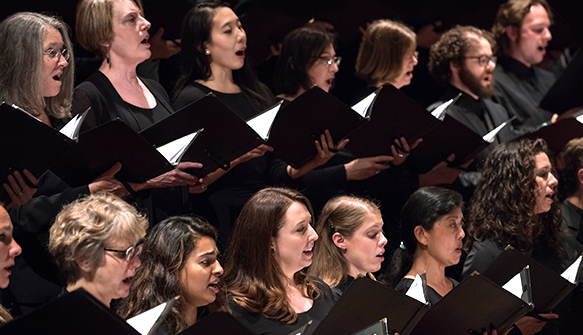
Berlioz’s Requiem: A Rafter-Shaking Experience
One of the greatest assemblies of musicians and singers ever at Davies Hall came together this week for Hector Berlioz’ grand, grand Requiem mass of 1837, performed with immense reverence. It’s an Olympic-sized budget-breaker that shakes the rafters on an awe-inspiring scale, making all the other hundreds of requiems in the repertory seem like mere chamber music.
The Frenchman Berlioz is duly credited with great orchestration skills, greatly broadening the known sonic spectrum a mere decade or so after Schubert and Beethoven were both gone. The extremes of loud-soft contrasts as well as high-low pitches underlined his reaching for the ultimate, to produce a mass for the dead beyond anything ever heard till then, or (as far as I can find) since.
Much of this is somber and slow-paced, without a vocal soloist. One imagines its creator prostrating himself before the Creator with a profound sense of inferiority, pleading for salvation. Until arriving 20 minutes into the opus with a full-blown brassy outburst coming not just from the stage but also from niches near the rafters, offset against no less than eight timpanists, you’re not sure all these mighty forces will come into play. But when they do, they may set off wild swings on local seismographs, perhaps to be registered as the unforgettable Davies Hall quake.
Some of the 10 sections with the traditional Latin text are outstanding. The stormy Lacrymosa (“Lamentable Is the Day”) is absolutely brilliant in its offbeat 6-8 tempo for the choristers, sounded unstable in its reaction to the tragedy. Here there is no high-church solemnity, but rather mobility and animation with laudable counterpoint, as if a forerunner to Verdi’s much later Requiem.
When a vocal soloist finally does appear toward the end in the “Sanctus,” it’s like some Gabriel guiding us out of a damned morass into high ground. There’s musical subtlety too, with cymbal “massages” that are barely audible. All leading to a fugue that even Handel would have been proud of.
Leading this 80-minute opus, the veteran Swiss-French Charles Dutoit was as much guide as conductor, cuing the macro-forces without much time for micro insights. Apart from some tempo diversion in the “Dies Irae,” he held them together rather well, battling the tendency toward turgidity. Given more than 100 instrumentalists on stage and another 18 brass players in at least five elevated niches, plus close to 240 singers, at times the man on the podium is more like general of all of Rome’s armies than a lone speechless figure on the podium.
The three massed choruses had no better luck with enunciating consonants than the usual SFS Chorus, rendering it almost impossible to follow the program texts—“sanctus” sounded much like “salva me.” While the basses rumbled along more contentedly than clearly, the sopranos soared into the high registers gloriously.
But Berlioz the romantic was all about the grand gesture, not about intelligibility. The short solo by dramatic tenor Paul Groves lifted one’s spirits where most needed.
This Berlioz is not the perfect requiem, but the emotion is profound, and the impact lasting, even in the delicate unaccompanied “Quaerens me” chorus. And it marked a key breakthrough for Berlioz, the perennial Parisian outsider coming in from the distant Isère/Savoie region bordering Dutoit’s Switzerland.
MUSIC NOTES—The only work in the 37-year history of Davies Hall using larger forces has been Mahler’s Symphony (“of a Thousand”) Number 8.
Berlioz’ Requiem, with the S.F. Symphony and augmented choruses and brass, heard May 4 at Davies Symphony Hall, S.F. For SFS info: (415) 864-6000 or go online.